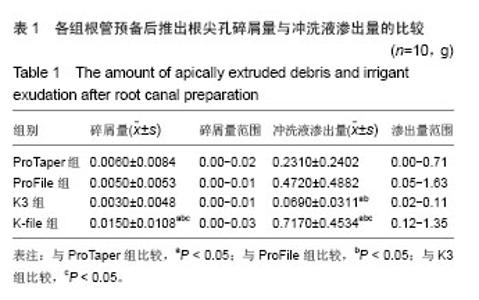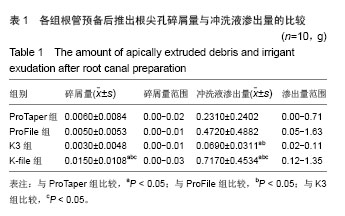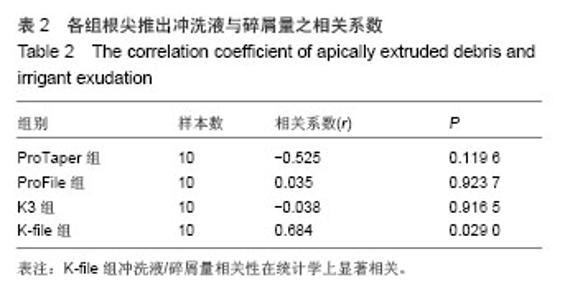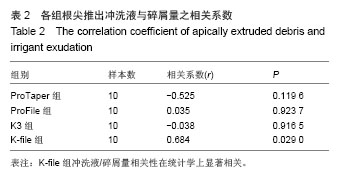| [1]Schilder H.Cleaning and Shaping the root canal.Dent Clin North Am.1974:18(2):269-296.
[2]Seltzer S,Naidorf IJ.Flare-ups in endodontics:1.Etiological factors.J Endod. 1985,11(11):472-478.
[3]Siqueira JF,Rocas IN, Favieria A,et al.Incidence of postoperative pain after intracanalprocedures based on an antimicrobial strategy.J Endod.2004;28:457-460.
[4]Vande Visse JE,Brilliant JD.Effect of irrigation on theproduction of extruded material at the root apex duringinstrumentation.J Endod.1975;1(7):243-246.
[5]Fairbourn DR,McWalter GM,Montgomery S.Theeffect of four preparation techniques on the amount ofapically extruded debris.J Endod.1987;13(3):102-108.
[6]McKendry DJ.Comparison of balanced forces, endosonic,and step-back filing instrumentation techniques: quantificationof extruded apical debris.J Endod.1990;16(1):24-27.
[7]Myers GL,Montgomery S.A comparison of weights ofdebris extruded apically by conventional filing and CanalMaster techniques.J Endod.1991;17(6):275-279.
[8]Bidar M,Rastegar AF,Ghaziani P,et al.Evaluation of apically extruded debris in conventional androtary instrumentation techniques.JCalifDentAssoc.2004;32(9):665-671.
[9]Capar ID,Arslan H,Akcay M,et al.An In Vitro Comparison of Apically Extruded Debrisand Instrumentation Times withProTaper Universal,ProTaper Next, Twisted File Adaptive, and HyFlexInstruments.J Endod.2014; 40(10):1638-1641.
[10]葛久禹.镍钛根管预备器械[J].中国实用口腔科杂志,2014, 7(1):2-9.
[11]Locke M,Thomas MB,Dummer PM.A survey of adoption of endodontic nickel-titanium rotary instrumentation part 1: general dental practitioners in Wales. Br Dent J.2013; 214(3):E6,1-10.
[12]刘文哲,陈广盛.机用镍钛器械ProTaper Next和ProTaper Universal在模拟根管内成形的能力[J].中国组织工程研究, 2014,18(34):5418-5422.
[13]Jamleh A,Komabayashi T,Ebihara A,et al.Root surface strain during canal shaping and its influence on apical microcracks development: A preliminaryinvestigation.Int Endod J.2014 [Epub ahead of print].
[14]Sowmya HK,SubhashTS,Goel BR,et al.Quantitative Assessment of Apical Debris Extrusion and Intracanal Debris in the Apical Third, Using Hand Instrumentation and Three Rotary Instrumentation Systems. JClinDiagnRes. 2014;8(2): 206-210.
[15]YeterKY,Evcil MS,Ayranci LB,et al.Weight of apically extruded debris following use oftwo canal instrumentation techniques and twodesigns of irrigation needles.Int EndodJ.2013;46(9): 795-799.
[16]陈造,彭明,高玉桥.手用不锈钢K 锉和机用Profile 镍钛锉在根管预备中碎屑推出根尖孔的实验观察与比较[J].广东牙病防治, 2007, 15(7):310-312.
[17]Garlapati R,Venigalla BS,Patil JD,et al.Quantitative evaluation of apical extrusion of intracanal bacteria using K3, Mtwo, RaCe and protaper rotary systems: Anin vitrostudy.J Conserv Dent. 2013;16(4):300-303.
[18]Burklein S,Schafer E.Apically Extruded Debris with Reciprocating Single-File and Full-sequence Rotary Instrumentation Systems.J Endod.2012;38(6):850-852.
[19]Walton RE.Histologic evaluation of different methods of enlarging the pulp canal space.J Endod.1976;2(10): 304-311.
[20]Aller MA,Arias JI,Alonso-Poza A.A review of metabolic staging in severely injured patients.Scand J Trauma Resusc Emerg Med. 2010;18:27.
[21]Law AS,Nixdorf DR,Aquirre AM,et al.Predicting Severe Pain after Root Canal Therapy in the National Dental PBRN.J Dent Res.2014;29:1S-7S.
[22]Ip HY,Abrishami A,Peng PW,et al.Predictors of postoperative painand analgesic consumption: a qualitativesystematic review. Anesthesiology.2009;111(3):657-677.
[23]Matusow RJ.The flare-up phenomenon in endodontics: a clinical perspective and review. Oral Surg Oral Pathol.1988; 65(6):750-753.
[24]Georgopoulou M,Anastassiadis P,Sykaras S,et al.Pain after chemomechanical preparation. Int Endod J.1986;19(6): 309-314.
[25]Holland R, Desouza V,Nery MJ,et al.Tissue reactions following apical plugging of the root canal with infected dentin chips. Oral Surg Oral Pathol.1980;49:366-369.
[26]VandeVisse JE,Brilliant JD.Effect of irrigation on the production of extruded material at the root apex during instrumentation.J Endod.1975;1(7):243-246.
[27]Yeter KY, Evcil MS, Ayranci LB,et al.Weight of apically extruded debris following use oftwo canal instrumentation techniques and twodesigns of irrigation needles. Int Endod J. 2013;46(9):795-799.
[28]Salzgeber RM,Brilliant JD.An in vivo evaluation of the penetration of an irrigating solution in root canals.J Endod. 1977;3(10):394-398.
[29]Tronstad L.Tissue reactions follwing apical plugging of the root canal with dentin chips in monkey teeth subjected to pulpectomy.Oral Surg Oral Pathol.1978; 45(2):297-304.
[30]Ruiz-Hubbard EE,Gutmann JL,Wagner MJ.A quantitative assessment of canal debris forced periapically during root canal instrumentation using two different techniques. J Endod.1987;13(12):554-558. |



